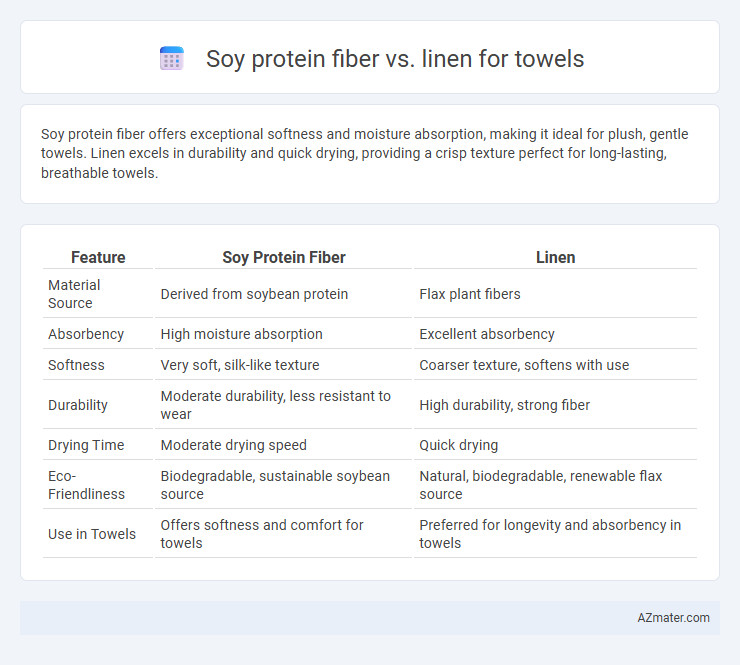Soy protein fiber offers exceptional softness and moisture absorption, making it ideal for plush, gentle towels. Linen excels in durability and quick drying, providing a crisp texture perfect for long-lasting, breathable towels.
Table of Comparison
| Feature | Soy Protein Fiber | Linen |
|---|---|---|
| Material Source | Derived from soybean protein | Flax plant fibers |
| Absorbency | High moisture absorption | Excellent absorbency |
| Softness | Very soft, silk-like texture | Coarser texture, softens with use |
| Durability | Moderate durability, less resistant to wear | High durability, strong fiber |
| Drying Time | Moderate drying speed | Quick drying |
| Eco-Friendliness | Biodegradable, sustainable soybean source | Natural, biodegradable, renewable flax source |
| Use in Towels | Offers softness and comfort for towels | Preferred for longevity and absorbency in towels |
Introduction: Soy Protein Fiber vs Linen for Towels
Soy protein fiber towels offer exceptional softness, high absorbency, and natural biodegradability, making them an eco-friendly alternative to traditional fibers. Linen towels, derived from flax plants, are celebrated for their durability, quick-drying properties, and antimicrobial benefits, which enhance freshness during frequent use. Choosing between soy protein fiber and linen towels depends on preferences for texture, sustainability, and long-term performance.
What is Soy Protein Fiber?
Soy protein fiber is a sustainable textile material derived from the protein of soybeans, combining natural softness with moisture-wicking properties ideal for towels. Unlike linen, which is made from flax fibers known for durability and quick drying, soy protein fiber towels offer enhanced absorbency and a silky texture. This innovative fiber also contributes to eco-friendly production by utilizing agricultural by-products and supporting biodegradable towel options.
What is Linen?
Linen is a natural fiber made from the flax plant, known for its durability, breathability, and moisture-wicking properties, making it ideal for towels that dry quickly and resist bacteria growth. Compared to soy protein fiber, which is derived from protein in soybeans and offers softness and eco-friendliness, linen provides a textured, sturdy weave that enhances absorbency and longevity. Towels made from linen maintain their strength even when wet, offering a sustainable and high-performance option for everyday use.
Sustainability and Eco-Friendliness
Soy protein fiber towels offer superior sustainability due to their biodegradable nature and low water consumption during production compared to traditional materials. Linen towels, made from flax plants, are highly eco-friendly with minimal pesticide use and a naturally durable fiber that extends product lifespan. Both fibers provide renewable alternatives to synthetic towels, but soy protein fiber is often favored for its rapid biodegradability and lower environmental footprint.
Absorbency and Drying Performance
Soy protein fiber towels exhibit excellent absorbency due to their hydrophilic properties, often surpassing linen in soaking up moisture quickly. Linen fibers, while naturally breathable and strong, tend to dry faster than soy protein fiber because of their open fiber structure facilitating better air circulation. Choosing between the two depends on whether superior water absorption or rapid drying is the priority for towel usage.
Softness and Comfort Comparison
Soy protein fiber towels offer exceptional softness due to their smooth texture and excellent moisture absorption, making them gentle against sensitive skin. Linen towels, while highly durable and breathable, have a naturally coarser feel that improves with age but initially lacks the plush comfort found in soy protein fiber. Combining soy protein fiber's silky softness with linen's strength results in towels that balance comfort with longevity for everyday use.
Durability and Longevity
Soy protein fiber towels exhibit impressive durability due to their strong, flexible fibers and resistance to pilling and wear from repeated washing. Linen towels, crafted from flax fibers, are renowned for their exceptional longevity, becoming softer and more absorbent with each wash while maintaining structural integrity. Both materials provide durable options, but linen's natural fiber strength generally offers superior long-term performance for towels subjected to frequent use.
Allergy and Skin Sensitivity Factors
Soy protein fiber towels offer hypoallergenic properties and are naturally gentle on sensitive skin due to their smooth, protein-rich composition that minimizes irritation and itching. Linen towels, while breathable and durable, can sometimes cause mild sensitivity in individuals prone to allergies because of their coarser texture and natural fiber content. Choosing soy protein fiber is ideal for users seeking allergy-resistant, soft textiles that reduce the risk of skin flare-ups and irritation.
Maintenance: Washing and Care Requirements
Soy protein fiber towels require gentle washing in cold water with mild detergent to maintain softness and prevent fiber weakening, avoiding bleach and high heat drying. Linen towels are more durable, tolerating higher temperatures and regular washing, but benefit from air drying to preserve fiber integrity and prevent shrinkage. Both materials require careful handling to extend lifespan, with linen offering easier maintenance for heavy use and soy protein fiber demanding more delicate care routines.
Price and Value for Money
Soy protein fiber towels generally offer a higher price point due to their sustainable production and natural softness, making them a premium choice for eco-conscious consumers. Linen towels, while often more affordable and durable, provide excellent moisture-wicking properties and longevity, delivering strong value for money in everyday use. Comparing cost-effectiveness, linen typically stands out for long-term investment, whereas soy protein fiber towels appeal to buyers prioritizing comfort and sustainability despite the higher cost.

Infographic: Soy protein fiber vs Linen for Towel
 azmater.com
azmater.com